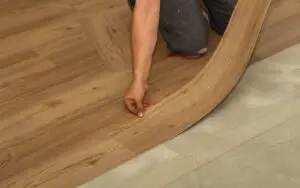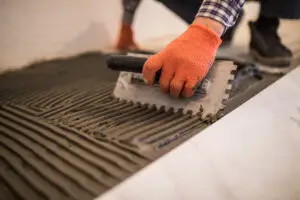Understanding Your Flooring Needs: Budget vs Quality
Assessing Your Budget
Setting a Realistic Financial Limit
When considering new flooring, the first step is to set a realistic budget. Determine how much you can comfortably spend without overextending your finances. This involves considering all aspects of the project, not just the cost of the materials themselves. Knowing your financial constraints from the outset will help you narrow your options and avoid the temptation to overspend.
Understanding Long-Term Costs
While a low initial price is attractive, it’s important to think about the long-term costs associated with cheap flooring. This includes maintenance, repairs, and eventual replacement. Sometimes spending a bit more upfront for a more durable option can save you money in the long run. When hiring a professional, they can give advice about the long-term value of any options you may consider.
Defining Your Flooring Requirements
Room Type and Function
The type of room where you plan to install new flooring will significantly impact the flooring you choose. A bathroom, for example, will require a moisture-resistant material, while a living room may prioritize style and comfort. Think about how the room will be used and the specific demands you’ll be placing on the floor.
Traffic Levels and Durability
Consider the amount of foot traffic the area receives daily. High-traffic areas such as hallways, kitchens, and living rooms require more durable flooring options that can withstand wear and tear. Choosing a flooring material that is not suited for your specific traffic levels can lead to needing to replace them sooner than expected. A professional can advise you on the best options based on this.
Top 5 Cheapest Flooring Options
Vinyl Flooring: Versatile and Affordable
Types of Vinyl Flooring (Sheet, Plank, Tile)
Vinyl flooring is a popular choice due to its versatility and affordability. It comes in various forms including sheet vinyl, vinyl planks, and vinyl tiles, each offering different installation methods and aesthetic options. Sheet vinyl is typically the cheapest and is suitable for large areas where seamless flooring is desired. Vinyl planks and tiles are more versatile and can mimic the look of wood or stone.
Cost-Effectiveness and Durability
Vinyl flooring is known for being water-resistant, easy to clean, and relatively durable, making it a good option for many areas. Its cost-effectiveness, paired with its relative ease of installation makes it a good option for homeowners looking to save on labor costs. While it’s not indestructible, professional installation can help in maximizing the flooring’s life.
Laminate Flooring: Budget-Friendly and Stylish
Advantages of Laminate Flooring
Laminate flooring offers a balance between affordability and style. It’s a great option for those looking for the look of hardwood without the high cost. Laminate is easy to install and comes in a variety of styles and designs, offering many choices that suit the decor of many homes.
Limitations of Laminate Flooring
While laminate is more affordable than hardwood, it can be susceptible to water damage and can be less durable in high-traffic areas. It’s essential to choose a high-quality laminate and take care to prevent spills to extend its lifespan. Professional installation can help with this, ensuring that the subflooring is adequate and that the planks are installed to avoid any gaps or premature damage.
Carpet: Soft and Inexpensive
Types of Carpeting
Carpet is another affordable option, particularly for bedrooms and living rooms where comfort is prioritized. It comes in various materials, textures, and colors, offering homeowners flexibility in their choices. Carpet can also help reduce noise and create a warmer feel in your home.
Considerations for High-Traffic Areas
While carpet is budget-friendly, it may not be the best choice for high-traffic areas because it is harder to clean and can show wear and tear quickly. Spills can easily stain, and dirt can quickly accumulate in high-traffic areas, requiring frequent cleaning and ultimately causing it to need replacement sooner than other flooring types.
Engineered Wood: A Mid-Range Alternative
Cost vs Solid Hardwood
Engineered wood is a more cost-effective alternative to solid hardwood, offering a similar aesthetic for a lower price. It consists of a thin layer of real wood over a core of plywood or fiberboard, making it more stable and less prone to warping than solid wood.
Advantages and Disadvantages
While engineered wood is more affordable than solid hardwood, it is more expensive than laminate or vinyl. It offers a great balance between cost, durability, and appearance. However, it may not be as durable as solid hardwood and still has a higher price point compared to other cheap flooring options.
Concrete Flooring: Modern and Economical
Preparing Concrete Floors for Living Spaces
Concrete floors, when properly prepared, can be a stylish and cost-effective option. They are incredibly durable and easy to clean, making them a popular choice in modern homes. However, concrete floors need to be properly treated to be suitable for living spaces.
Decorative Options for Concrete Flooring
Concrete floors can be customized with staining, polishing, and various finishes, allowing for a wide range of decorative options. This makes them a great choice for those who want a unique, industrial look without breaking the bank. When choosing a concrete floor, it’s important to make sure that the subfloor is professionally prepped to make sure that there are no issues down the road, especially with moisture and cracking.
DIY vs Professional Installation: The Cost Factor
The True Cost of DIY Flooring Installation
Potential Errors and Extra Expenses
While DIY flooring installation can seem like a money-saving option, it often comes with hidden costs. Mistakes made during the installation process can lead to wasted materials, extra expenses, and the need for future repairs. This is why, although DIY seems less expensive, it often becomes more expensive, due to the additional costs to correct any mistakes or issues.
Time Commitment and Frustration
DIY projects can also be very time-consuming and frustrating, especially if you do not have prior experience. What seems like a simple process can turn into a long, stressful, and challenging project that may leave you with a result you are not happy with. The time that is spent on a project such as this may not be worth the money that you save.
Why Professional Installation Offers Better Value
Expertise and Efficiency
Professional flooring installers have the experience, training, and tools necessary to complete the job efficiently and correctly. They know how to avoid common mistakes, properly prepare the subfloor, and ensure that the flooring is installed perfectly and ready to stand the test of time. Professional installation is often quicker and more accurate than what a DIYer can achieve.
Long-Term Cost Savings and Warranty
Although hiring a professional may cost more initially, it often leads to long-term cost savings by preventing the need for future repairs, and by providing a warranty, which is something a DIYer cannot provide for their own work. The peace of mind that comes with professional installation, paired with the knowledge that you are getting the best product and service is something you can’t put a price on.
Case Study: DIY vs Professional Installation Cost Analysis
Examples of Hidden DIY Costs
A homeowner decided to install vinyl flooring themselves, opting to save on labor costs. However, they made several errors, including not properly leveling the subfloor and misaligning the vinyl planks. The result was an uneven floor with gaps and seams, which then had to be repaired, increasing their cost.
Benefits of Professional Pricing Transparency
In contrast, another homeowner hired a professional installer. While the initial cost was higher, the professional assessed the area, provided a clear cost estimate that included all labor and materials, and completed the job quickly and efficiently. The homeowner was happy knowing they were getting quality work, and there were no surprises with hidden costs.
Ensuring Long-Term Value
Professional Installation for Cost-Effective Results
How Professionals Maximize Material Usage
Professional installers can maximize material usage by precisely measuring the room, cutting materials with minimal waste, and utilizing methods that prevent errors. This means you will have less waste, save money, and ultimately be more efficient in the installation.
Protecting Your Investment with Professional Installation
By ensuring that the flooring is installed correctly from the start, professionals can help protect your investment. Proper installation prevents future issues such as buckling, warping, and moisture damage, thereby saving you a lot of money and time.
Proper Maintenance for Long-Lasting Flooring
Cleaning and Care Tips for Each Flooring Type
The type of cleaning and care required differs by the flooring material. Vinyl and concrete are easy to clean with simple cleaning solutions. Carpet requires regular vacuuming and occasional professional cleaning to prevent stains and buildup. Understanding the needs of your specific flooring is important in helping it last as long as possible.
When to Seek Professional Flooring Maintenance
While regular maintenance at home can help keep the flooring in good condition, there are times when it is best to seek professional help. A professional can assess any damages, perform deep cleaning, and offer solutions for any issues you may be experiencing, or help with ongoing maintenance.
FAQs & Answers
While DIY flooring installation may seem cheaper initially, the cost of mistakes, wasted materials, and potential future repairs can quickly add up. Professional installers offer expertise, efficiency, and warranties that can protect your investment in the long run. They also have better access to quality materials at a lower cost, ultimately making it a more cost-effective option in many cases. Therefore, to avoid unexpected expenses and achieve the best results, professionals are often the best and most efficient choice.
The lifespan of any flooring, even the cheapest options, is heavily influenced by proper maintenance and care. Professional installation ensures that the flooring is correctly installed to maximize its durability and prevent premature wear. Regular cleaning, avoiding harsh chemicals, and using appropriate protective measures like rugs and furniture pads can significantly extend the lifespan of your flooring, saving you money and time in the long term. Professionals can help you choose the right flooring material and provide the best maintenance advice for your specific situation.
For high-traffic areas, durable options like vinyl or quality laminate are often recommended. While these options may not be the absolute cheapest, they are much more resistant to wear and tear than other budget choices like carpet. Professional installers can advise on the specific grade and type of flooring needed to withstand heavy use, ensuring it looks good and lasts longer, preventing the need for frequent and costly repairs or replacements. Therefore, a durable and efficient installation is the best way to go, and is often found with a professional.
With the advancements in manufacturing, many budget-friendly flooring options can look stylish and attractive, without sacrificing quality or style. However, the key is professional installation that takes your preferences and concerns into account. A good installer will be able to show you the best options for your particular space, ensuring the best outcome, and ensuring that your cheap flooring looks good for years to come.
Hidden costs associated with cheap flooring options can include subfloor preparation, the cost of underlayment, and the tools and equipment that may be needed for installation. DIY installations often miss these costs, leading to unexpected budget overruns and potentially faulty installations. Professional installers, on the other hand, can assess your home and needs and accurately determine all the potential costs involved, ensuring a more transparent, efficient, and hassle-free experience.





